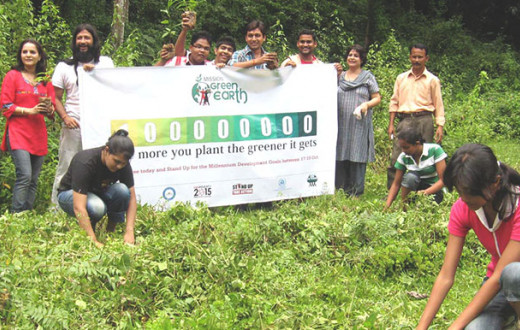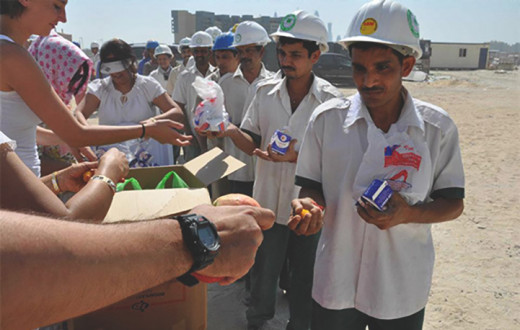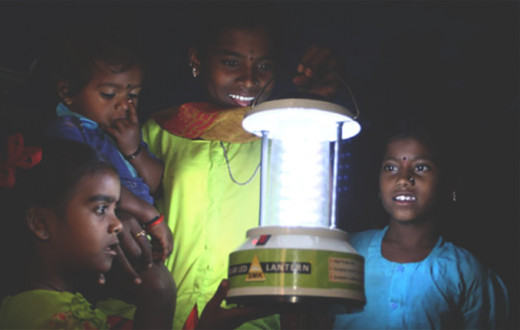“Education is this civilization’s greatest leveler. It has the power to empower the weakest of the weak, bring peace to the world and alleviate poverty. It is often seen as the only lit path in the pursuit of happiness.”
- Gurudev Sri Sri Ravi Shankar
Short summary
Inspired by Gurudev Sri Sri Ravi Shankar's vision of value education for all, The Art of Living provides free holistic and value-based education to children that are outside the reach of other government or private programs through its program called ‘The Care for Child’ also known as the ‘Gift A Smile.’
The effectiveness of the education provided is measured through:
- Academic performance
- Overall success and satisfaction of the child
- Development of children in all spheres of life: social, psychological and material.
Our challenges and approach
Many Art of Living schools operate in remote areas with limited access, where financial distress in the family makes children drop out so they can contribute to the family income. In some cases, safety is a concern due to an insurgency in the region.
The focus is on value-based education that helps strengthen the mind through yoga, meditation, and other inner transformational techniques. The methodology promotes cognitive, physical, emotional, social, and spiritual growth, thus leading to an education that is holistic.
Schools under the Gift a Smile program fall into three categories: rural, tribal and slum schools.
Rural Schools
Rural Schools are run in villages closer to cities typically with road access and electricity. To encourage attendance at school, free transport, meals, uniforms, books and bags are provided and parents are counseled about the importance of education. The attendance rate is 98% and the dropout rate is zero.
Tribal Schools
The term ‘tribals’ refers to small groups in India whose ethnic origins, culture and lifestyle differ from mainstream Indian society. They are typically in remote areas, surrounded by forests and no roads and electricity. Most are economically challenged and the culture of tribal groups preserved for thousands of years now faces the threat of extinction.
The first schools were set up in 1999 in the tribal areas of Jharkhand, West Bengal and Tripura and now there are 20 tribal schools taking care of over 2800 children. These schools have 97% attendance with a dropout rate of less than 15%. 48% of the students are girls – this is not common in these areas. The teachers are recruited from local areas and trained in the Teacher's Training Institute.
Slum Schools
Urban slums face unique challenges including poverty, hygiene issues and overcrowding. Children from slums are often malnourished and caught in a web of crime and violence. Located in the hearts of cities, the disparity between the urban and slum dwellers is a constant impression on the young minds. Lack of availability of free education makes them vulnerable to addictions like drugs, alcohol and susceptible to crime to earn money.
Impact:
Over 53,361 students receive free education in 422 schools across 20 states of India
in the rural, tribal and slum belts where child labor and poverty are widespread
First-generation school-goers
among many of the students
Reduced child labor and early girl-child marriage
in villages with Art of Living schools
Featured projects
- The Art of Living’s 1st school
- Jharkhand Tribal School
- A New Hope @ The Wall of Death
- Dharavi School
- Victim of child labor turns into a provider of education
The Art of Living’s 1st school, rural Bengaluru, India
The Ved Vignan Maha Vidhya Peeth (VVMVP) was the first rural school started by Gurudev Sri Sri Ravi Shankar in 1981. The project started when Gurudev observed some local children playing in the dust near The Art of Living Center without access to education. A local volunteer was appointed to look after the children to give them basic lessons in hygiene, teach them educational games, and to serve them free healthy food for lunch. The school started attracting more students and a formal educational structure was established. Initially, daily wage earners were reluctant and children from only two villages attended the school. Today, the numbers have grown exponentially.
One of the students was a young girl called Priyanka. She studied from 8th to 10th standard, topped the school 10th standard exams, went on to do a diploma course in Electrical & Electronics and then got a job in Bengaluru Metro Rail Cooperation Ltd. She piloted the 1st Bangalore Metro as its train operator.
“At this young age, my daughter would have been working in the farms. We never dreamed she would get an education! I am so happy to see her going to school!”
- Mrs. Savitri, a parent whose child is a first-generation school-goer
Jharkhand Tribal School: Taking education to the Hinterlands
In 1999, when Gurudev asked Brij Chawla to do something for education in tribal areas, he resigned as General Manager in Bhartiya Cutler Hammer to work for Naxal-affected tribes in Jharkhand. He chose Ghatsila, deep in the tribal belt. One has to jump several feet to get off the train in the dark, with just a few minutes to do so. Chawla is in his 70s and often travels with big boxes carrying uniforms or books or other school material.
Today, there are 20 tribal schools dotted on Jharkhand’s map. Schools that have a high-quality infrastructure, including a multimedia room run by solar power. The instruction of education begins in local languages: Mundari and Oraon, and uses the Akiki script.
“My daughter, Dukhi, is the first person in our entire family to be getting an education. The others do not even know how to read or write. We are very grateful for this.”
- Jaba Soren, Jharkhand, whose daughter studies in one of the tribal schools run by The Art of Living
A New Hope @ The Wall of Death
After undergoing the Youth Leadership Training Program, Hiramati Sinha decided to open a free English medium school at the "Wall of Death" on the India-Bangladesh border in Bhuvaneshwarnagar, Assam, in 2003. She visited 1,500 families and encouraged parents to send their children. Despite a lukewarm response, Hiramati started Sri Sri Gyan Mandir with only 15 children. It now runs with almost 600 students. Several students are from local fishermen families, who are not educated themselves. A number of children of Armed Forces have also studied here.
Hiramati was given the Dr. B.R Ambedkar National Philosopher Award by Bharath Dalit Sahitya Academy in December, 2015, for opening this school. She has also started schools in Broninglo and Keipleo of the N.C. Hills District, in Dhargarband of the Karimgaj District, and in Khasiapuji of the Kasar District, some of which are insurgent areas.
Dharavi School: A Center of Education in Asia’s Largest Slum
Sri Sri Vidya Mandir is the first English medium school in Dharavi, Asia’s largest slum. Despite numerous challenges, such as the children’s difficult backgrounds with a history of abuse, unavailability of land, and parental indifference towards education, the school has thrived and succeeded in bringing education to the local residents. Over 400 children study at the Dharavi School.
Victim of child labor turns into a provider of education
Vinod Chauhan’s father was an alcoholic tailor and his mother a seasonal farm laborer. Due to his father’s habit, Vinod and his brother had to start working in a tea shop from morning to midnight, followed by a series of odd jobs – selling kites, selling vegetables, gardening, and so on. “We weren’t encouraged to focus on our education. I failed class 10 twice, and I did not even know how to read or write Hindi properly at that age.”
After finishing YLTP, Vinod got inspired to study, cleared class 10, and went on to complete his graduation in Commerce. “The growth in my personal life gave me more and more confidence and resolve to bring education to the children of poorer communities. I want to help other children, so they don’t go through what I had to. My dream is to see every child educated and to see them blossom into independent individuals.” Today, he runs a free school for over 250 students from poor communities in Dhar, Madhya Pradesh.







